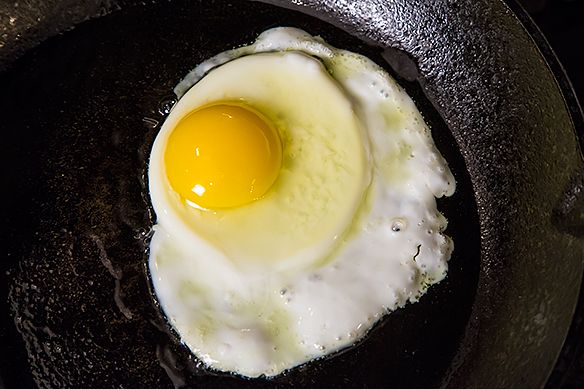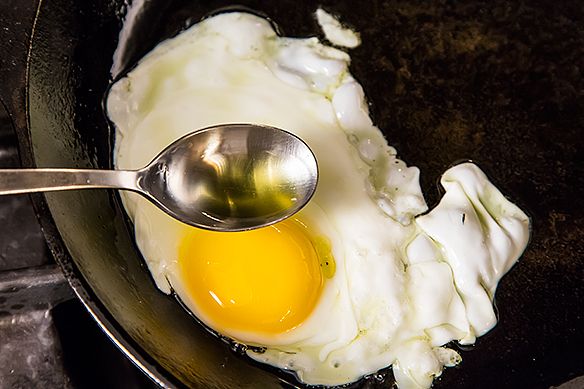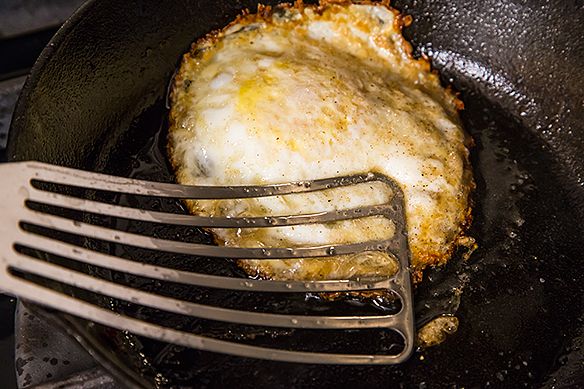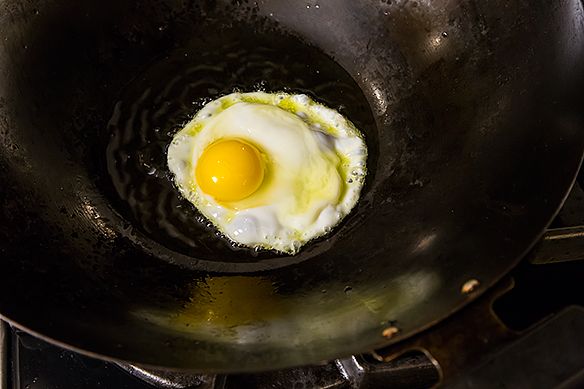Popular on Food52
68 Comments
allisonking
November 13, 2018
Perfect to me means fully set whites with soft edges, and a runny/creamy yolk. Heat olive oil on medium, add egg and let sit just until the edges start to set, then add just enough water to protect the edges from crisping. Cover til whites are fully set.
Leo L.
August 5, 2015
Turn off the heat means a whole lot more if cooking with gas or electricity. Turning of gas means your cooking with holdover heat of the pan your using. Turning off electricity and your are dealing with holdover heat of the burner and the pan with entirely different results. The comments don't speak to the cooking method gas or electricity.
Mona T.
July 29, 2015
The best fried egg/omelette I've had was on a street side breakfast stand in Luang Prabang, Laos. Scramble 3 orange-yolked eggs with salt and pepper, in 1T shimmering peanut oil in a wok, med-high heat, fry sliced shallots and scallions (white and green parts) briefly, and pour the eggs. When the bottom is golden and shallots/scallions caramelize (1 min max), flip it over and fry 1 min. Served with steamed sticky rice and papaya/mango/watermelon smoothie, it was heavenly breakfast.
lisina
July 29, 2015
The Jose Andres fried egg is a revelation. Especially atop a spicy plate of chilaquiles at Oyamel.
Ryan P.
March 26, 2015
heat pan, drop in some Fromager d'Affinois, crack egg over the top. guaranteed best egg you've ever eaten.
Sally Z.
March 25, 2015
hot cast iron pan, knob of butter that browns immediately. crack egg or two into middle of pan. Sprinkle lightly with montreal seasoning. let cook until edges are set and brown. Flip for just a cursory warming, then lift onto plate. yields crispy bottom, runny yolk. be sure to have some good toasted whole grain toast to sop it up.
Tony
January 27, 2015
Over easy in either olive oil or butter, and seasoned with a sprinkle of Balsamic Vinegar
Ashley M.
March 8, 2014
My perfect fried egg does NOT have a runny yolk! I prefer the "animal" version of the press-down method, cooked to a CREAMY yolk.
James R.
February 26, 2014
I like to fry the egg in a little butter. When set well, I add a teaspoon or so of water , cover the pan and steam until the top is set. Perfect egg everytime!
ctcbox
February 26, 2014
Most mornings I use the press-down method with herb infused olive oil, usually garlic oil. In general I never (rarely) use plain oil. It's so easy to make flavored oils and they are soooo tasty, why not...
You could really do your readers a favor and do an article about hot and cold infused oils. You could addeess matching the herb with the oil, herbaceous vs woody stemmed, hot vs cold, infusion time, etc. i'll bet it would be a big hit. AND you would be doing a great service to society by helping people get away from the same old bland and tasetless...
I enjoyed your egg article. Thank you.
You could really do your readers a favor and do an article about hot and cold infused oils. You could addeess matching the herb with the oil, herbaceous vs woody stemmed, hot vs cold, infusion time, etc. i'll bet it would be a big hit. AND you would be doing a great service to society by helping people get away from the same old bland and tasetless...
I enjoyed your egg article. Thank you.
Paula E.
May 8, 2014
I agree with that, ctcbox. I would love to know about cooking eggs with herbaceous oils.
Gregg E.
November 4, 2013
I like my eggs fully cooked but without any of that nasty burning around the edges. Heat the skillet, put in a little butter or olive oil and a dash of salt and pepper. Crack in two eggs, break the whites and yolks. When the bottom is firm enough, flip then turn down to warm or simmer and cover for a couple of minutes - however long it takes to just fully cook the eggs.
Manuel B.
November 4, 2013
My version: Separate yolk from white. Cook the white in butter until set. Turn over. Add the yolk on top and serve after a minute. You get crispy and fully cooked whites with a runny yolk. Bon apetit!
Tessa G.
November 3, 2013
I like my eggs cooked so that the whites are completely solid, & the yolks are like pudding. I crack the egg & let the white drain into the bowl while keeping the yolk inside the shell. Then I use a spoon to remove the "umbilical cord" from the yolk (yuck!), & gently slide the yolk into the bowl with the white. The pan I use to make fried eggs doesn't need oil or anything to keep the eggs from sticking. I heat the pan over the lowest flame I can get. When a drop of water sizzles, I slide the egg onto the skillet (Since I have separated the white & the yolk, I've popped the sack that normally forms in the white, around the yolk. This helps to get all of the white cooked. If i crack the egg directly onto the skillet, I take a knife & cut around the yolk, breaking this sack, otherwise, the white tends to stay runny along the edge of the yolk.). I salt & pepper the egg, then use a glass domed lid to cover the egg, & let it cook slowly, until the white is almost entirely solid, then carefully turn it over with a spatula, & place the lid over it again. I take it out of the skillet when the yolk feels sponge-like when you poke it with your finger.
mike
November 3, 2013
How long do you take for breakfast? 2 hours...you're worried about the 'umbilical cord of the egg? please...think about what you eat..well don't because you might like it.
TJ B.
November 3, 2013
I am happy to hear that I'm not the only one in the world who removes the yolk's "umbilical cord" (or chalazae). I don't know why, but it freaks me out.
Tessa G.
November 4, 2013
I'll totally admit that I'm weird when it comes to eggs. It only takes about ten minutes, at most, for me to cook them the way I like them. When it comes to food, I believe that you should make it how YOU like it. Otherwise, why bother?? When I cook, it doesn't matter how long it takes to achieve the results that I want (I once stirred a pot of polenta for four hours!). What matters is whether or not it tastes good to me. I never said that my way of cooking eggs was the best or only way of cooking eggs. I simply described how I make fried eggs. Time is not a factor when I cook... results are.
Tessa G.
November 4, 2013
I've had people tell me that the eggs have the chalazae, as you put it, when they are not fresh. I've had people tell me that they have it when they are too fresh. I've had eggs straight from the chicken's butt, & they still had it. Around 95% of the eggs I've cracked have had it. All brands, brown, white, speckled... it doesn't matter. I remove it because I am personally grossed out by it. I find it in my eggs when I order them out. I find it in cakes. I find it in anything that has been made with whole eggs. It's a little white cord that never mixes in or breaks up. I'm also glad to hear that someone else removes it & finds it icky!
ruth
November 3, 2013
Best fried egg with yellow yolk and no crisp edges: oil in moderately hot pan. Crack egg(s) into pan and season with salt and pepper to taste. As soon as the egg(s) start to sizzle cover the pan, turn off the heat and let them finish cooking while you make your toast. To me these are perfect.
Mary
November 3, 2013
The very best way I have found to fry an egg is to melt butter in the pan, when it is hot evenly coat bottom of pan. Add egg and cook on medium to high heat until the whites are about 80% done. Take 1/8 cup water, pour in the pan, cover, reduce heat and the steam generated cover/cooks the yolk tops. Ready to serve! Perfectly done whites, gently covered but soft yolks. A real breakfast treat!!
Stephanie W.
November 1, 2013
i trie ao damn hard to cook the whites thru w/ out over cooking the yolk & i fail all the time. what am i doing wrong?? seems like the only way to have runny yolks is to half cook the whites! ughhh. sucks cause i love eggs! i like what im reading here but the instrucions seem complicated. help.
martinlaw
November 1, 2013
Stephanie, not to worry. It's not rocket science. A little butter or margarine in, preferably, a non-stick skillet on medium heat. Once the whites start to turn opaque, add 1-2 tablespoons of water to the pan (I like to put it into the lid and dribble it around the outside of the egg. Put the lid on, and when the yolk starts to 'cloud over', the whites will be done and the yolks still runny. Cook them as little or as much as you want. Hope that works for you.
Ashley M.
March 8, 2014
Wish I had your problem! My difficulty is getting the yolk firm enough without over cooking the white!
Barbara H.
June 3, 2013
I love my whites as crispy as I can get them, with a totally liquid yolk, so when I have the time and energy to devote to this, I separate my eggs, and cook the whites alone over fairly high heat until they're as crispy as I have the patience for. Then I add the yolks and swirl the pan to quickly warm them, and plate. Crispy whites in a yolk sauce - yummers!
Doug E.
May 19, 2013
For me the best method is fried in a non stick pan in fresh bacon fat from quality cured middle bacon. Crack the egg into the pan with a reasonable heat as I like a slightly crispy edged white to compliment a luxuriously runny yoke. Let egg settle then baste with the bacon fat and 'brown bits' until the yoke has 'whited' over. Serve immediately ideally with a bacon fat fried slice, black pudding and the bacon that gave off the glorious fat. Salt and Pepper to taste. Yum!







See what other Food52 readers are saying.